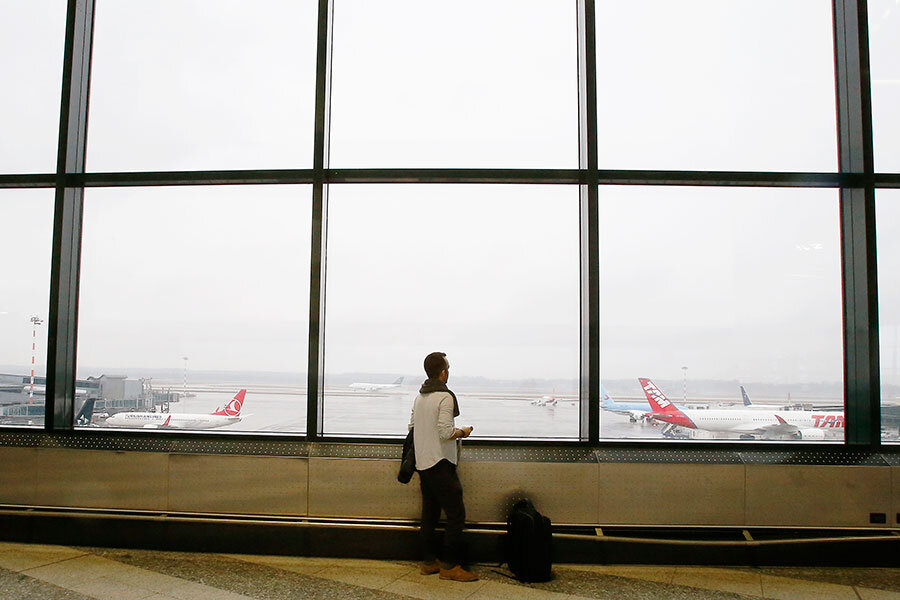In Trump's orders, a test of America's checks and balances
Loading...
[Update: This story has been updated at 8:10 a.m.]
For a week, chaos reigned. Protesters massed outside airports, lawyers filed lawsuits across the country late into the night, and thousands of immigrants to the United States were thrown into legal limbo by President Trump’s executive order.
There was confusion and claims by some that the administration appeared to ignore judicial orders.
Then, something normal happened.
Courts ruled, the administration obeyed, and – at least for a brief moment – the dust settled. Specifically, a federal judge in Washington temporarily blocked the order from being enforced nationwide last Friday (just hours after a federal judge in Boston had ruled the opposite way), and the Trump administration complied.
Although Mr. Trump has continued to criticize the decision, the Department of Homeland Security has stopped enforcing the order, the State Department is allowing those with valid visas to enter the country (after saying it previously revoked as many as 100,000), and the Justice Department is arguing its case through the courts, where Vice President Mike Pence has said he is “very confident that we’re going to prevail.”
A federal appeals court is now scheduled to hear arguments in the case Tuesday.
On one hand, a president who vowed to shake up Washington has clearly done just that – and more. But viewed another way, this past week has simply been a new test of America’s centuries-old checks and balances – with a new president testing the limits of executive power and the courts pressing the pause button, at least for now.
“What we’re seeing is a salutary operation of checks and balances,” says Ernest Young, a constitutional law professor at Duke University School of Law.
“A lot of presidents come into office with a very broad view of what they’re going to be able to do,” he adds. “It’s not that uncommon [to be blocked by the courts], but that’s how the system is supposed to work.”
Where things stand now
The Supreme Court, for example, blocked President Obama’s executive action on immigration. The high court also blocked President George W. Bush’s executive order putting Guantánamo Bay detainees on trial before military commissions.
But Trump’s order has added new layers of confusion, some say. Not only was the order broad – suspending the entry of people from seven majority-Muslim countries for 90 days, the admissions of any refugees for 120 days, and the admission of refugees from Syria indefinitely – but it was crafted and implemented poorly, they say.
That seemed to create only more confusion.
At Dulles International Airport in Virginia, US Customs and Border Protection (CBP) officials refused to allow lawyers and congressmen access to people being detained. At John F. Kennedy International Airport in New York City, CBP agents tried to remove classes of immigrants protected by the injunction, the Guardian reported. And at Los Angeles International Airport, CBP officials detained some immigrants in the days after the order was signed, according to a court filing from the American Civil Liberties Union of Southern California.
Now, many of those detainees have been released, and what may have appeared to some to be the administration flouting judicial orders instead might simply have been confusion and misinformation, says Professor Young.
“If that sort of behavior continued, that would be a real problem,” he adds. Then, “if they refused to comply with court orders [beyond] that point we would have a constitutional crisis.”
There has not been much evidence of that, says Lee Gelernt, a lawyer at the ACLU national office who argued one of the first cases challenging the executive order. There have been some isolated cases of people not being allowed to board flights to the US over the past week, but they were all eventually able to get on flights.
The legal path ahead
Civil rights groups are still monitoring the situation and how it was first handled, Mr. Gelernt says. A lawsuit filed in district court in Philadelphia, for example, claims that CBP officers told two Syrian-born men with valid visas they had to either leave the US on the flight they had arrived on or be arrested and have their visas taken away. Other immigrants claim in legal briefs to having been forced by border officials to sign documents waiving their right to enter the United States.
“Exactly what is happening on the ground remains unclear,” says Gelernt. “If we hear about noncompliance we’re prepared to go to court immediately.”
A three-judge panel of the US Court of Appeals for the 9th Circuit – Judge William Canby Jr., a President Carter appointee; Judge Richard Clifton, a President George W. Bush appointee; and Judge Michelle Taryn Friedland, a President Obama appointee – will hear arguments in the case on Tuesday. Either side could ask the Supreme Court to intervene if they disagree with the decision, but with the high court still absent a justice and split ideologically down the middle, a 4-to-4 tie would preserve whatever decision the appeals court reaches.
In blocking Trump’s executive order, federal District Judge James Robart cited a federal court decision in 2015 that blocked Mr. Obama’s executive actions on immigration.
The role of the judiciary, he wrote, “is limited to ensuring that the actions taken by the other two branches [of government] comport with our country’s laws, and more importantly, our Constitution.”
“The circumstances brought before [the court] today are such that it must intervene to fulfill its constitutional role in our tripart government,” he continued.
Justice Department lawyers have argued Judge Robart's order was "vastly overbroad" and that the executive order was "a lawful exercise of the President's authority over the entry of aliens into the United States and the admission of refugees."
However the courts ultimately rule, recent days have sent a message, says Gelernt.
“One thing we’ve learned over past 10 days is that the courts will not be cowed into simply rubber stamping administration policies.”








